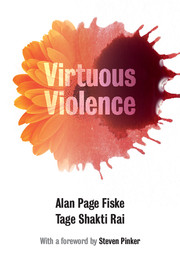Book contents
- Frontmatter
- Dedication
- Contents
- Figures and tables
- Foreword
- Warm thanks
- The point
- 1 Why are people violent?
- 2 Violence is morally motivated to regulate social relationships
- 3 Defense, punishment, and vengeance
- 4 The right and obligation of parents, police, kings, and gods to violently enforce their authority
- 5 Contests of violence: fighting for respect and solidarity
- 6 Honor and shame
- 7 War
- 8 Violence to obey, honor, and connect with the gods
- 9 On relational morality: what are its boundaries, what guides it, and how is it computed?
- 10 The prevailing wisdom
- 11 Intimate partner violence
- 12 Rape
- 13 Making them one with us: initiation, clitoridectomy, infibulation, circumcision, and castration
- 14 Torture
- 15 Homicide: he had it coming
- 16 Ethnic violence and genocide
- Chapter 17 Self-harm and suicide
- 18 Violent bereavement
- 19 Non-bodily violence: robbery
- 20 The specific form of violence for constituting each relational model
- 21 Why do people use violence to constitute their social relationships, rather than using some other medium?
- 22 Metarelational models that inhibit or provide alternatives to violence
- 23 How do we end violence?
- 24 Evolutionary, philosophical, legal, psychological, and research implications
- The dénouement
- References
- Index
13 - Making them one with us: initiation, clitoridectomy, infibulation, circumcision, and castration
Published online by Cambridge University Press: 05 December 2014
- Frontmatter
- Dedication
- Contents
- Figures and tables
- Foreword
- Warm thanks
- The point
- 1 Why are people violent?
- 2 Violence is morally motivated to regulate social relationships
- 3 Defense, punishment, and vengeance
- 4 The right and obligation of parents, police, kings, and gods to violently enforce their authority
- 5 Contests of violence: fighting for respect and solidarity
- 6 Honor and shame
- 7 War
- 8 Violence to obey, honor, and connect with the gods
- 9 On relational morality: what are its boundaries, what guides it, and how is it computed?
- 10 The prevailing wisdom
- 11 Intimate partner violence
- 12 Rape
- 13 Making them one with us: initiation, clitoridectomy, infibulation, circumcision, and castration
- 14 Torture
- 15 Homicide: he had it coming
- 16 Ethnic violence and genocide
- Chapter 17 Self-harm and suicide
- 18 Violent bereavement
- 19 Non-bodily violence: robbery
- 20 The specific form of violence for constituting each relational model
- 21 Why do people use violence to constitute their social relationships, rather than using some other medium?
- 22 Metarelational models that inhibit or provide alternatives to violence
- 23 How do we end violence?
- 24 Evolutionary, philosophical, legal, psychological, and research implications
- The dénouement
- References
- Index
Summary
If you love your children and want them to become just like you; if you deeply identify with kin or age-mates and they deeply want to become one with you; if you meet someone you want to incorporate into your group, bond with, and become able to trust with your life; in short, if you want and need to create the most intense and enduring CS relationships with someone for the rest of your life, then in many cultures you must cause them excruciating pain by cutting their genitals, terrify them and inflict degrading suffering, or beat them horribly. That is, you must circumcise a boy, excise a girl, initiate them, “jump them in” to the gang, or haze them into the fraternity. Severe initiation creates life-long CS bonds of unconditional altruism and total identity with the other initiates, with the initiators, and with others whose bodies are marked like theirs. So in communities whose existence totally depends on absolute, selfless loyalty, people violently initiate their sons and daughters, brothers and sisters, nephews and nieces, grandsons and granddaughters. Love, identification, and the moral obligation to forge unbreakable commitment to CS bonds – they are what motivates cutting genitals, horrific initiations, and other kinds of group-incorporation violence. The pain itself is crucial to the formation of the CS identity with the initiating group; indeed, the pain may be experienced as the sacrifice of an aspect of the self for the group as a whole (Morinis, 1985).
Initiation rites
A child becomes an adult, or an outsider becomes an insider when ritually controlled pain weakens the subject’s sense of empirical identity and strengthens his or her sense of attachment to a highly valued new center of identification.
(Glucklich, 2001: 7)- Type
- Chapter
- Information
- Virtuous ViolenceHurting and Killing to Create, Sustain, End, and Honor Social Relationships, pp. 179 - 190Publisher: Cambridge University PressPrint publication year: 2014

